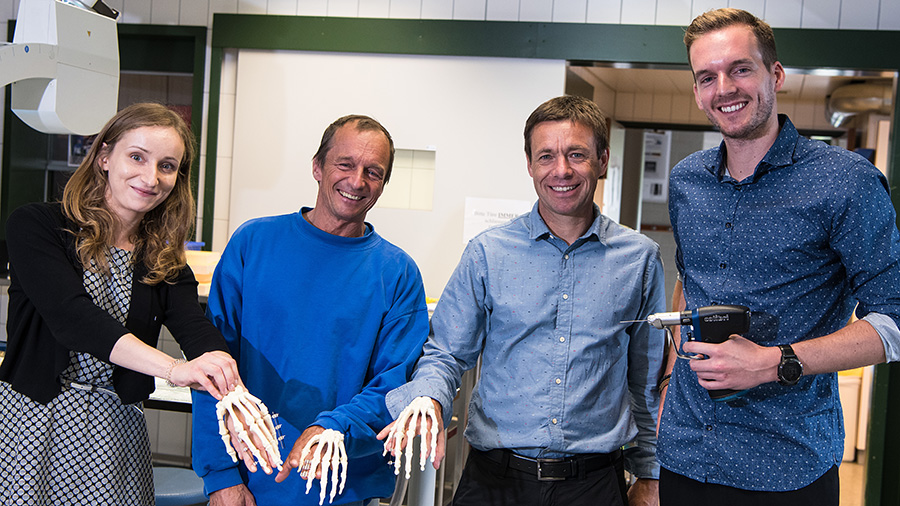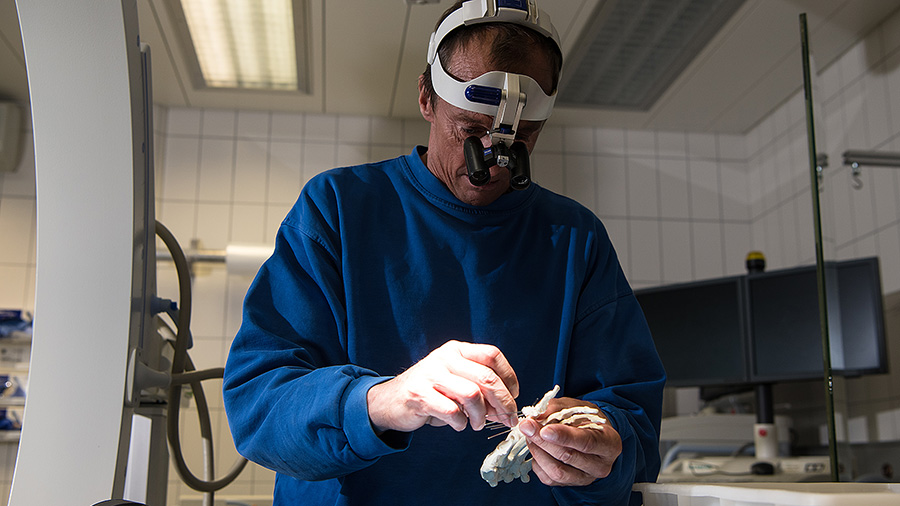Small bone external fixator

Surgeon’s innovation comes to life, thanks to AO Development Incubator’s expertise
An AO-educated surgeon with more than 20 years of experience in reconstructive surgery is seeing his own innovation vision come to life, thanks to support from the AO Development Incubator (AO DI). As a springboard for innovations outside of the domain of the AO Foundation’s industrial partners, the AO DI is helping Karl Heinz Bürger, MD, move his invention—a new system for the external fixation of fingers—toward proof of concept and valorization.
The system employs snap-on brackets that can hold horizontal rods of a fixation brace in place and represents a simpler, more affordable and efficient fixation solution. Bürger, an Austria-based surgeon serving patients in more than 40 hospitals in central Europe each year, is proud to assert that his invention supports the AO’s mission of promoting excellence in patient care and outcomes in trauma and musculoskeletal disorders. Like many innovations that eventually changed the world, Bürger’s invention began with a problem.
“Over the course of my career, one of the problems I have consistently encountered is that Kirschner wires (K wires)—which are commonly used for fixation of the bones in the fingers—aren’t stable enough for rigid fixation of the phalanx,” he explained. “Of course, titanium plates are available today, but they are very expensive, not available at every hospital, and it’s not always possible in an acute trauma situation to open the soft tissue sufficiently to achieve fixation with a plate.”
Bone cement is another option, he said, but it is an expensive, time-consuming—and very unforgiving—one.
“Bone cement is stable, but you can’t immediately correct the fixation after it dries,” Bürger explained.
Innovating a better solution
Regularly faced with these constraints, Bürger became determined to develop a better solution. With his concept in mind, he turned to a product design expert—who just so happened to be one of his patients—for insight. That expert is Markus Hirsch, founder of Hirsch Advanced Technologies based in Klagenfurt, Austria.
“Markus came in for a postoperative checkup and he said, ‘Heinz, what can I do for you?’ I told him my idea for fixing two K wires together—and within a couple of days he had a prototype ready for me to examine,” said Bürger.
Even with a prototype in hand and every reason to believe it represented a quick, affordable, stable and tissue-preserving means of fixing fractures in small bones, Bürger faced another hurdle: While he is an expert surgeon, he isn’t a product development specialist.
“Without proof of concept, it would be impossible to attract a commercial partner to bring this new system to market. I shared this frustration with my friend, Dr Georg Lajtai of the
Privatklinik Maria Hilf in Klagenfurt am Wörthersee, Austria, and he referred me to his friend who suggested that I show my product to the AO.”
And that’s just what Bürger did. He took his invention to the AO DI, which specializes in funding selected inventors to build and execute their projects toward proof of concept and valorization, with the AO and the inventor sharing project development and generated value. Managed by a board bridging both the medical and industrial worlds, the AO DI is backed by the AO’s 60-year innovation legacy built on the insights and bold innovations of experienced surgeons like Bürger: committed to promoting excellence in the treatment of trauma and musculoskeletal disorders.
Today, with AO Development Incubator support, the behind-the-scenes work toward proof of concept and valorization is well underway. Documentation is being gathered for Conformité Européene (CE) certification, which is expected in the first half of 2019; testing in clinics is scheduled to start in the second half of 2019.
“We have the expertise to support inventors with certification, clinical evaluation and reports, testing, feasibility and detailed specifications—and we use our own network to accelerate the speed of AO Development Incubator projects and guarantee a high-quality outcome,” said AO Development Incubator Program Manager Roland Herzog. “Overall, we now have a project portfolio ranging from longer-term projects of great technical complexity to projects, like Dr Bürger’s fixation system, that are very close to market application.”
As his project moves closer to becoming a reality, Bürger’s enthusiasm for improving his patients’ lives continues to grow.
“I want this solution to be available to hand surgeons all over the world so that they can better treat their patients,” he explained. “It has never been my plan to be a great inventor of medical implants, but to provide a better solution for clinicians and patients. The AO Development Incubator is making that possible.”



